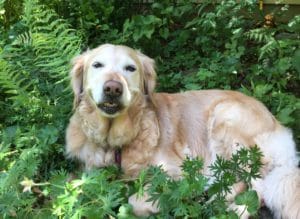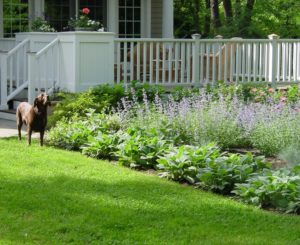Hello fellow readers, There’s much to consider when gardening with dogs.
Doggie garden dilemmas & remedies
Doggone diggers are only part of the challenge when you have canine kids. The risk of trampling while playing, noshing while bored, yellow lawn spots, or leg lifting on branches are other doggie considerations. You may recall Ed’s teenage pup Dulcie who eats the blue fescue she digs up? Bill from Bangor suggested never let your dog watch you plant as she’ll think you’re burying something tasty, and chances are will go back and dig up your plants. A great tip- become a closet gardener (smile).
I sympathize when dogs cause plant devastation. My first couple of puppies, littermates Sara and Sadie, provided a jumpstart on doggie parenting. Our first spring together, I planted an ambitious perennial garden and took precautions to deter deer with an organic spray named Bobbex. Deer stayed away; pups rolled, perennials flattened, lesson learned. Pick a deer spray that doesn’t smell like a decaying animal.
Choose the right plants.
And choose plants that readily spring back from trampling or rolling, especially on the edge of your garden. Good bets are Coral bells /Heuchera, Catmint/ Nepeta, and Bugleweed/ Ajuga; ‘Catlin’s Giant’ is a 10″ variety that performs as more than a groundcover. There’s Bearberry (Arctostaphylos uva-ursi), Creeping Thyme such as Thymus praecox, Stonecrop (Sedum acre), Wormwood (Artemisia) and Tickseed (Coreopsis) – all tough plants and highly deer resistance.
Set large boulders to guard more tender plants or prized shrubs or trees. And save your delicate plants for pots that you can intersperse in your garden. Coarse gravel or river stone along the border of your garden may help as dogs prefer to walk on a smooth surface.
Designated potty spots are a matter of training, but marking territory (leaving pee-mail) is an instinct that is tough to control. Create marking spots with large pieces of driftwood that can also serve as border guards at the edge of your garden. Keeping your lawn 3-4″ high hides the yellow spots and is better for your lawn as the height helps deter weeds.
Does it sound as though I became a doggie expert? The truth is, we learn to adapt to our dogs and let go of perfection because unconditional love is well worth a few garden casualties.
Garden dilemmas? askmarystone@gmail.com
Here’s the link to Gardening with Dogs Part 1
The ASPCA website for pet-friendly plants https://www.aspca.org/pet-care/animal-poison-control/toxic-and-non-toxic-plants




